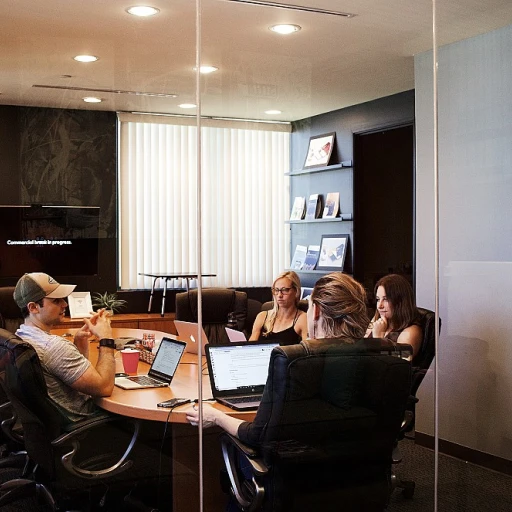Understanding Leadership Vision
Understanding Leadership's Direction
Engaging with senior leaders can provide invaluable insights into the organization's overarching goals and ambitions. When asking questions, it's crucial to comprehend their vision for the company. This understanding not only provides clarity on the direction the senior leader aims to take but also helps align the day-to-day work of the team with broader strategic ambitions. Consider asking questions that probe into what the leadership sees as the future of the business. Questions like "What do you envision as the company's long-term success?" or "How do you see the company culture evolving over time?" can pave the way for revealing conversations. Such questions are insightful as they encourage senior executives to verbalize their aspirations, which can be motivating for team members who share in these goals. Understanding a senior leader's vision also aids in navigating the subtly shifting organizational culture. Being attuned to strategic priorities is essential for identifying challenges and how innovation and adaptability fit into their leadership style. These factors are pivotal for ensuring the team is aligned with an evolving vision. Through these discussions, you'll gain a clearer picture of what leadership views as the best practices and where they see opportunities for improvement. For example, if senior leaders emphasize a balance between work and life, it indicates a commitment to professional development and employee engagement. Leadership conversations often highlight the importance of decision making and digital transformation as pathways for future career growth. For more insights on fostering effective communication and a vibrant corporate culture, you can explore strategies on breaking barriers in office management.Navigating Company Culture
Exploring the Fabric of Organizational Dynamics
Understanding the nuances of company culture is essential for anyone aiming to navigate the corridors of power within an organization. When engaging with senior leaders, it's vital to probe the cultural elements that define how the business operates on a day-to-day basis. Company culture often acts as the backbone for strategic alignment and guides how team members interact, make decisions, and drive overall success. When you're interacting with senior executives, consider asking questions that delve into how the current culture came to be and what it stands for. Engaging in discussions around culture can help in assessing whether there's alignment between leadership vision and the actual experiences of the team. Questions to consider might include:- How do our cultural values influence decision-making processes in the organization?
- In what ways do you see our culture evolving to meet new business challenges?
- Are there elements of our culture that you believe are critical to our long-term success?
Strategic Priorities and Challenges
Aligning with Strategic Vision
For office managers looking to engage meaningfully with senior executives, understanding and aligning with the company's strategic vision is essential. Engaging senior leaders through targeted interview questions can provide deeper insights into their strategic priorities and challenges. In turn, this helps you better navigate the daily operations that align with these objectives.
Consider asking questions that elucidate the organization's long-term goals and the associated challenges. For instance, "What are the key strategic priorities for the company in the next 3-5 years?" This question helps in understanding the direction senior leaders envisage for the company, and how your team can contribute to this roadmap. Thoughtful follow-up questions can also reveal how your team's priorities can align with these goals, fostering a supportive environment for both business growth and employee engagement.
Strategic priorities often come with a unique set of challenges. Leaders may face obstacles like digital transformation, competition, or adapting to market changes. Inquiring about these challenges using strategic questions such as, "How is the organization preparing to tackle upcoming challenges in our industry?" provides clarity on potential obstacles and what is expected from your team during these transitions.
Understanding company strategy not only assists in aligning team objectives but also improves decision making at your level. It prepares you to better support your team members by anticipating changes within the company and industry. By maintaining alignment with senior executives' vision, office managers play a crucial role in navigating company challenges and driving success.
To see how teams aligning their efforts with company goals can influence morale and productivity, visit this insightful guide on boosting morale through project completion celebrations.
Innovation and Adaptability
Embracing Change and Fostering Creativity
In today's rapidly evolving business landscape, the ability to innovate and adapt is crucial for any organization aiming for long-term success. Engaging with senior leaders about how they approach innovation can provide valuable insights into their leadership style and strategic decision-making processes. It's essential to ask questions that delve into how the company encourages creativity and manages change.
Consider asking senior executives about the following:
- Innovation Initiatives: What current projects or initiatives are in place to foster innovation within the team? Understanding these can help you align your efforts with the company's strategic priorities.
- Encouraging Creativity: How does the leadership team encourage creative thinking among team members? This can reveal much about the company culture and the value placed on employee engagement.
- Adapting to Change: How does the organization handle changes in the market or industry? Exploring their adaptability strategies can provide insights into their readiness for digital transformation and other challenges.
These questions not only help in understanding the company's approach to innovation but also highlight the importance of adaptability in achieving business success. They can also serve as a follow-up to discussions about leadership vision and company culture, providing a comprehensive view of how senior leaders drive the organization forward.
Leadership Development and Succession Planning
Developing Future Leaders
In any thriving organization, nurturing the next generation of leaders is a crucial component of long-term success. Senior leaders play a pivotal role in shaping the leadership development framework within the company. They must ask themselves questions about how to effectively identify and cultivate potential leaders from within their teams. This involves not only recognizing talent but also providing the necessary resources and opportunities for professional development.
One approach is to implement mentorship programs where experienced leaders can guide emerging talent. This not only aids in skill development but also in instilling the organization's values and culture in future leaders. Senior executives should consider strategic questions such as:
- What skills and qualities do we want to see in our future leaders?
- How can we create a culture that encourages continuous learning and growth?
- What resources and support do we need to provide to help team members reach their potential?
Leadership development is not just about training; it’s about fostering an environment where team members feel empowered to take initiative and innovate. This links closely with the company culture and the strategic priorities that senior leaders have set. By aligning leadership development with the organization's vision and challenges, companies can ensure that they are well-prepared to adapt and thrive in a changing business landscape.
Furthermore, succession planning is an integral part of this process. Senior leaders should regularly review and update their succession plans to ensure that the organization is not caught off guard by unexpected changes. This involves asking questions about the readiness of potential successors and the effectiveness of current development strategies.
Ultimately, by focusing on leadership development and succession planning, senior leaders can help secure the future of the organization, ensuring that it remains resilient and competitive in the face of evolving challenges.
Feedback and Communication Channels
Building Effective Feedback Loops
Engaging with senior leaders often involves understanding how feedback and communication channels operate within the organization. To foster a culture of transparency and continuous improvement, it's essential to explore how these channels are structured and utilized.
One of the key questions to ask senior executives is how they gather feedback from team members and what mechanisms are in place to ensure this feedback is acted upon. This not only helps in identifying potential challenges but also in aligning the leadership's vision with the company culture.
Here are some strategic questions to consider when discussing feedback and communication with senior leaders:
- What are the primary channels for team members to provide feedback to senior leaders?
- How does the organization ensure that feedback is incorporated into decision making processes?
- What steps are taken to communicate back to employees about the changes or actions resulting from their feedback?
- How do senior leaders measure the effectiveness of their communication strategies?
- What role does digital transformation play in enhancing feedback and communication within the organization?
Understanding these aspects can significantly contribute to employee engagement and help in creating a work environment where people feel heard and valued. It's not just about collecting feedback; it's about creating a loop where feedback leads to meaningful change and improvement.
Senior leaders who prioritize open communication and actively seek input from their teams are often more successful in navigating the complexities of modern business. By asking the right questions, you can gain valuable insights into how your organization can enhance its feedback mechanisms and, ultimately, its overall success.











